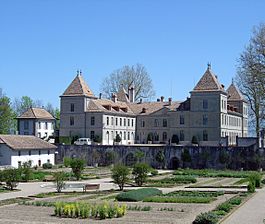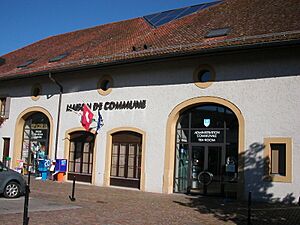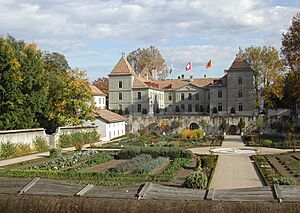Prangins facts for kids
Quick facts for kids
Prangins
|
||
|---|---|---|

Castle of Prangins
|
||
|
||
| Country | Switzerland | |
| Canton | Vaud | |
| District | Nyon | |
| Area | ||
| • Total | 6.07 km2 (2.34 sq mi) | |
| Elevation | 413 m (1,355 ft) | |
| Population
(Dec 2020 )
|
||
| • Total | 4,099 | |
| • Density | 675.3/km2 (1,749.0/sq mi) | |
| Postal code |
1197
|
|
| Surrounded by | Nyon, Duillier, Coinsins, Vich, Gland | |
Prangins is a town, also called a municipality, located in the Nyon area of Vaud in Switzerland. It sits right on the beautiful Lake Geneva.
Contents
History of Prangins
Prangins was first mentioned in old writings around the years 1135 to 1185. It was called Prengins back then.
After the Second French Empire ended, a famous person named Prince Napoléon Bonaparte and his wife, Princess Maria Clotilde of Savoy, lived in exile at the Prangins Castle. Later, Charles I of Austria and his family also stayed there for a short time, starting in May 1919.
Geography and Location
Prangins covers an area of about 6 square kilometers (about 2.3 square miles). A large part of this land, about 54.7%, is used for farming. Forests cover about 13.1% of the area.
About 31.3% of the land has buildings or roads on it. A small part, less than 1%, is made up of rivers or lakes.
Prangins is located on a raised area, like a terrace, on the northern side of the smaller part of Lake Geneva. The town includes the main village of Prangins and two smaller areas called Bénex and Promenthoux.
Prangins Coat of Arms
The coat of arms for Prangins shows a blue shield. On it, there is a silver tower with a roof. At the bottom, there are three silver hands shaking, coming from the left, right, and bottom sides.
People and Population
Prangins has a population of about 4,282 people as of 2023. Over the last ten years, the number of people living here has grown quite a bit. This growth is partly because new people move to Prangins and partly from births.
Most people in Prangins speak French. It is spoken by about 77.8% of the population. German is the second most common language, and English is the third.
The town has a good mix of ages. Many children and teenagers live here, making up about 27% of the population under 19 years old. There are also many adults and older people, showing a balanced community.
The chart below shows how the population of Prangins has changed over many years:

Important Heritage Sites
Prangins Castle is a very important historical place. It is listed as a Swiss heritage site of national significance. This means it's a special place that is protected because of its history and culture. The Villa Les Bleuets is also a nationally important site.
The whole village of Prangins is part of the Inventory of Swiss Heritage Sites. This means the entire area is recognized for its historical value and beauty.
Things to See and Do
Prangins has some interesting places to visit.
- The HBG facility is nearby. This is where a special time signal is sent out.
- Prangins is also home to one of the branches of the Swiss National Museum. You can learn a lot about Swiss history and culture there.
- The Aerodrome La Côte is an airport located between Prangins and Gland. It's a place where small planes can land and take off.
Economy and Jobs
In Prangins, many people have jobs in different areas.
- Some people work in the primary sector, which means they work in farming.
- Many people work in the secondary sector. This includes jobs in manufacturing, where things are made, and in construction, where buildings are built.
- A lot of people work in the tertiary sector, which includes jobs that provide services. This could be working in shops, restaurants, transportation, or even in healthcare and education.
Many residents of Prangins work within the town itself. However, some people travel to other towns for their jobs. Similarly, people from other towns come to Prangins to work.
Religion in Prangins
Based on information from 2000, about 34.9% of the people in Prangins were Roman Catholic. Another 34.6% belonged to the Swiss Reformed Church.
There are also smaller groups of people who follow other Christian churches, as well as Islam and Judaism. Some people in Prangins do not belong to any church.
Education and Learning
Many people in Prangins have completed a good level of education. About 34.2% have finished high school, and 23.7% have gone on to higher education, like university.
The schools in Prangins are part of the Vaud canton's school system.
- Children can attend two years of non-required pre-school.
- Primary school lasts for four years.
- Lower secondary school is required for six years.
Prangins is also home to a museum, the Musée national suisse - Château de Prangins. This museum is a popular place to visit, with many people coming to learn and explore each year.
See also
 In Spanish: Prangins para niños
In Spanish: Prangins para niños








